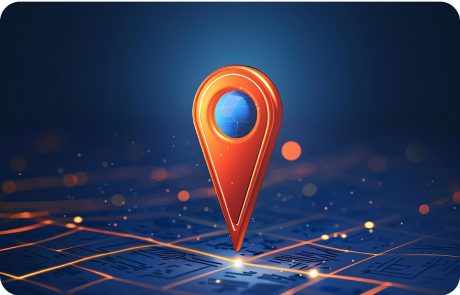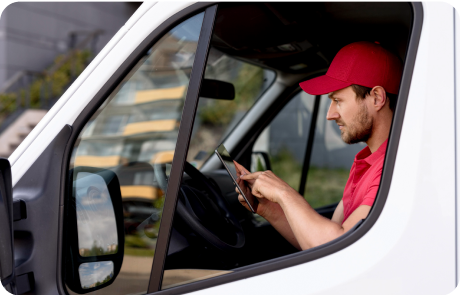Index Table
- 1. Introduction: Track Deliveries and Maximize Earnings with Mileage Tracking for Delivery Drivers
- 2. What is Mileage Tracking and Why is it Important?
- 3. Key Features to Look for in a Mileage Tracking App
- 4. Best Mileage Tracking Apps for Delivery Drivers
- 5. How Mileage Tracking Apps Work
- 6. Benefits of Using a Mileage Tracking App for Delivery Drivers
- 7. Choosing the Right Mileage Tracking Solution
- 8. Mileage Tracking for Tax Deductions
- 9. Best Practices for Using GPS Mileage Tracking Apps
- 10. Common Questions About Mileage Tracking
- 11. Conclusion: Maximizing Efficiency with the Right Mileage Tracking Solution
1. Introduction: Track Deliveries and Maximize Earnings with Mileage Tracking for Delivery Drivers
Tracking mileage and expenses is crucial to a delivery driver’s daily operations. With the right tools, drivers can avoid challenges such as inaccurate mileage records, missed tax deductions, and inefficient routes that cost time and money. Manually tracking mileage is time-consuming and prone to human error, which can lead to discrepancies in records and potential loss of income.
A mileage tracking app offers a reliable solution. These apps are designed to automatically track mileage, categorize expenses, and provide detailed reports to ensure drivers can maximize their earnings and reimbursement. By automating the tracking process, delivery drivers can focus more on their deliveries and less on administrative tasks.
Key Benefits of Using a Mileage Tracking App:
- Ensures accurate tracking of mileage for tax deductions.
- Helps drivers optimize delivery routes, reducing fuel costs and time.
- Minimizes the risk of errors associated with manual tracking.
- Automates the process, allowing drivers to track expenses and keep accurate records easily.
2. What is Mileage Tracking and Why is it Important?
Why is Mileage Tracking Crucial for Delivery Drivers?
- Maximize Tax Deductions: Accurate mileage tracking allows drivers to claim tax deductions for the miles they drive for deliveries. The more accurate the records, the higher the deduction potential.
- Optimize Delivery Routes: Mileage tracking apps often feature route optimization features. These help delivery drivers find the most efficient routes, saving time and reducing fuel costs.
- Meet IRS Requirements: Accurate records of business miles are necessary to meet IRS requirements. If drivers fail to keep proper records, they could lose out on deductions or face penalties during tax filing.
Additional Benefits:
- Mileage tracking can help delivery drivers manage their overall expenses by providing detailed reports on mileage and fuel consumption.
- It also helps differentiate between personal and business trips, making filing taxes and claim deductions easier.
3. Key Features to Look for in a Mileage Tracking App
GPS Tracking and Route Optimization
Why GPS Tracking Matters:
- Automatic Mileage Logging: Drivers no longer worry about manually entering their miles. The GPS logs each mile as the driver moves.
- Route Optimization: GPS tracking ensures drivers take the shortest, most fuel-efficient routes, reducing time on the road and saving fuel.
- Accurate Records: GPS technology ensures that every mile is accounted for, preventing missed trips or untracked miles.
Automatic Mileage Logging and Tracking
Benefits of Automatic Mileage Tracking:
- Time-saving: Drivers don’t have to spend extra time logging each trip manually. The app does it for them.
- Error Reduction: Since the app tracks mileage automatically, the risk of human error is greatly reduced.
- Real-time Tracking: Drivers can get real-time updates on the miles they have driven, helping them manage their routes more effectively.
Expense Management and Reporting
A good mileage-tracking app should track miles and help drivers manage their expenses. This feature allows drivers to categorize their expenses, such as fuel and maintenance costs, and provides detailed reports. These reports are essential during tax season and make filing business expenses much easier. For professionals looking for more comprehensive solutions, expense tracking for accountants provides additional tools to streamline financial management beyond just mileage, ensuring a broader view of all expenses.
Expense Management Features to Look For:
- Expense Categorization: Helps organize fuel, maintenance, and other expenses related to delivery operations.
- Comprehensive Expense Tracking: Drivers can track all business-related expenses alongside mileage, simplifying tax filing.
- Detailed Reporting: Provides detailed mileage and expense reports that can be used for tax purposes or reimbursement claims.

4. Best Mileage Tracking Apps for Delivery Drivers
Choosing the best mileage tracker app is crucial for delivery drivers who want to optimize their routes, track mileage accurately, and manage expenses effortlessly.
Below are contenders for the best mileage tracking app to meet the needs of your delivery driver:
Timeero – Accurate Multi-Stop Route Tracking
- GPS mileage tracking for accurate, real-time data.
- Multi-stop route optimization to help delivery drivers follow efficient routes.
- Automatic tracking, ensuring accurate records for tax purposes.
Routific – Intelligent Route Optimizer
- Live GPS tracking and route optimization.
- Real-time rerouting based on delivery priorities and proximity.
- Ability to track multiple deliveries with segmented tracking.
Everlance – Expense Management Module
- Automatic mileage tracking with GPS.
- Built-in expense tracking app to organize and categorize expenses.
- Detailed reporting for tax filing and deductions.
Unlock Productivity
Begin Your Free Trial Now!

5. How Mileage Tracking Apps Work
Mileage tracker apps have revolutionized how delivery drivers track mileage and manage their routes. They offer manual and automatic tracking options, GPS integration, and reporting features to streamline the tracking process. These apps also play a crucial role in mileage & expense management, helping drivers keep accurate records for tax purposes and optimize their overall operations.
Manual vs. Automatic Mileage Tracking
- Saves time by automatically tracking mileage.
- Reduces the risk of human error.
- Offers accurate record-keeping for tax purposes.
- Requires more time and effort from the driver.
- Higher chance of errors and missed mileage entries.
Integration with GPS and Mapping Services

Data Analysis and Reporting

6. Benefits of Using a Mileage Tracking App for Delivery Drivers
Increased Accuracy and Efficiency

Reduced Administrative Burden
Improved Tax Compliance



Boost Efficiency
Dive into a Free Trial Today!
7. Choosing the Right Mileage Tracking Solution
Considerations for Delivery Drivers
- Ease of Use: Look for a mileage tracker app that’s simple to use. It should track mileage automatically, minimizing manual input.
- Accuracy: Ensure the app provides accurate mileage tracking with GPS technology to avoid errors.
- Essential Features: Prioritize automatic tracking, route optimization, and comprehensive expense tracking to optimize delivery operations.
Evaluating App Features and Pricing
- Compare Features: Focus on apps that offer what you need—route planning, detailed reporting, and expense tracking.
- Pricing: Look for apps with a free trial or a free plan to test before committing to a paid version.
Reading Reviews and Ratings
- User Feedback: Check reviews and ratings to gauge real-world performance, ease of use, and accuracy. Reviews provide insights into how the mileage tracker performs in different delivery settings.
8. Mileage Tracking for Tax Deductions
Which Miles Count for Deductions?
- Business vs. Personal Miles: Only miles driven for business purposes (such as deliveries) are eligible for tax deductions. Use a mileage tracker app to separate personal and business trips.
How to Track Mileage for Tax Purposes
- Use a Mileage Tracker App: A reliable mileage tracker app will automatically log your business miles, ensuring accurate records for tax filing.
- Maintain Mileage Logs: Keep mileage logs for all your business trips, including dates, locations, and total mileage.
Tips for Maximizing Tax Deductions
- Update Logs Regularly: Ensure your mileage logs are current to avoid missing business miles.
- Categorize Expenses: Use your mileage tracker to track expenses such as fuel and maintenance, which can further maximize your deductions.
9. Best Practices for Using GPS Mileage Tracking Apps
Regularly Reviewing and Updating the Mileage Log
- Review Logs: Regularly check your mileage logs to ensure accuracy, especially for business trips.
- Update as Needed: Correct any missed trips or errors promptly.
Maintaining Accurate Records
- Essential Details: Record key information like trip dates, starting and ending points, and purpose. A mileage tracker app will automatically track these, but reviewing them ensures everything is correct.
Using Data to Optimize Routes and Expenses
- Optimize Routes: Use the data from your mileage tracking app to plan more efficient routes, reducing time and fuel costs.
- Track Expenses: Track all business expenses, including mileage, to simplify tax filing and improve business efficiency.
10. Common Questions About Mileage Tracking

What is the Standard Mileage Rate?

The IRS standard mileage rate calculates tax deductions for business miles. This rate changes annually and is based on vehicle operating costs. Drivers can use a GPS mileage tracking app to track mileage accurately and apply the standard rate to their tax deductions.

How Does the IRS Verify Mileage?

The IRS verifies mileage by reviewing detailed mileage logs, including the purpose of the trip, dates, and locations. Delivery drivers should use a mileage tracker app to log and store this information, ensuring compliance automatically. Keeping accurate records of tracked mileage is essential for proper tax filing.
11. Conclusion: Maximizing Efficiency with the Right Mileage Tracking Solution





